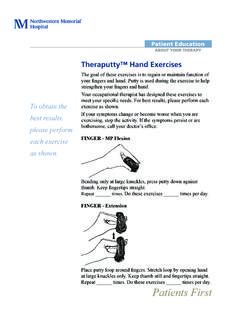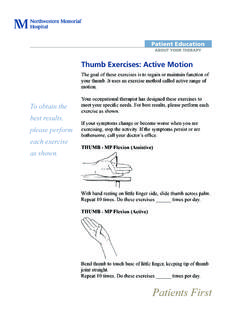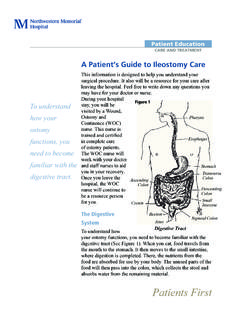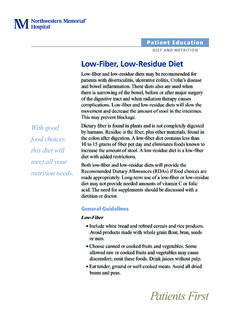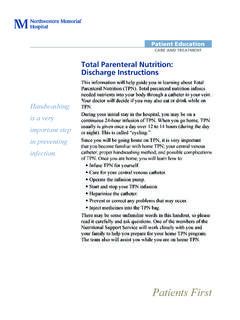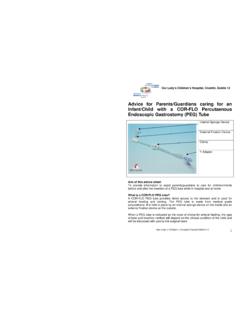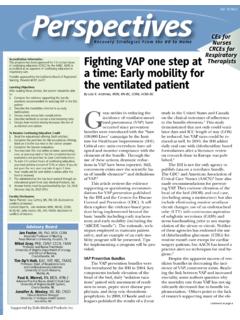Transcription of Tube Feeding Guidelines - nmh.org
1 Careful handwashing and a clean work surface help prevent Feeding GuidelinesThis information will guide you in learning about the procedure for tube Feeding . The tube Feeding formula provides calories, protein, vitamins and minerals. Sometimes it is prescribed to provide all the nutrition you may need. It also can be used to supplement meals if you are not able to eat enough. The Feeding may be given at intervals (intermittently) or continuously using a special Feeding of TubesThe Feeding tubes that go into the stomach through the nose are commonly called nasogastric (NG) Feeding tubes . tubes that are placed through a small hole in the skin into the stomach are called percutaneous endoscopic gastrostomy (PEG) or gastrostomy tubes (G-tube). A tube placed through a small opening in the skin into the small intestine is called a jejunostomy tube (J- tube). Some special tubes will actually be two tubes in one with openings into the stomach and the small intestine.
2 Ask your nurse or doctor which type of tube you tube type is the Work AreaBefore each tube Feeding and in caring for the PEG, G-tube or J-tube it is important to wash your hands and clean the work area. This will help prevent infection. Tables and other surfaces in your home normally have dust and some germs. The tabletop or surface you will use to prepare your tube Feeding should be clean and dry. Avoid areas where you prepare chicken or other meats. Choose a work area away from household traffic and pets. If the work surface is washable, clean it with soap and water and dry with a clean towel or paper EducationCARE AND TREATMENTP atients First If the surface is not washable, wipe it free of dust and spread a clean towel or paper towels over the surface. Wash your hands thoroughly with a liquid soap for 1 to 2 Tube Feeding Assemble the equipment you will need: formula, water, Feeding bag and 30 to 60 cc syringe.
3 Clean the work area and wash your hands. Close the clamp on the tubing of the Feeding bag. Slowly pour the formula into the Feeding bag. Hang the Feeding bag on a pole or hook about 1 to 2 feet above your head. Open the clamp and allow the formula to fill the tubing, removing all air. Close the clamp. Using the syringe, flush the Feeding tube with _____ cc of water. Connect the tubing of the Feeding bag to the Feeding tube. Open the clamp and regulate the flow so the Feeding drips in slowly, about _____ drops in one minute. When the Feeding is finished, close the clamp on the tubing of the Feeding bag. Disconnect the Feeding bag tubing from the Feeding tube. Using the syringe, flush the Feeding tube with _____ cc of water. Wash the Feeding bag with a little dishwashing soap. Rinse thoroughly so there is no soap film left in the bag and hang to : _____Number of feedings each day: _____Number of drops in one minute: _____Times of the feedings: _____Amount of feedings: _____ cc of formula to run over _____ minutes(or _____ hours if using a pump).
4 Tube flushes: _____ cc of water before and after each Tube FeedingArrangements for a special Feeding pump to be delivered to your home will be made before you leave the hospital. The home care supply company will give you specific information about using the pump and when to discard Feeding bags. Two Feeding bags will be needed. This allows for one bag to be washed/dried while the other bag is in use. The steps for starting a continuous tube Feeding are similar to those used for intermittent feedings. Assemble the equipment you will need: formula, water, Feeding bag, pump and 30 to 60 cc syringe. Clean the work area and wash your hands. Close the clamp on the tubing of the Feeding bag. Slowly pour the formula into the Feeding bag. Pour into the bag only enough formula for 8 to 12 hours. Hang the Feeding bag on a pole or hook about 1 to 2 feet above your head. Open the clamp and allow the formula to fill the tubing, removing all air.
5 Close the clamp. Connect the Feeding bag tubing to the pump and adjust the pump settings. Using the syringe, flush the Feeding tube with _____ cc of water. Connect the tubing of the Feeding bag to the Feeding tube. Open the clamp and start the pump. Using the syringe, flush the Feeding tube with _____ cc every 4 to 6 hours through a flush port. If there is no flush port, stop the pump, disconnect the Feeding bag tubing and flush the Feeding tube. When the Feeding is finished, stop the infusion and flush the tube with _____ cc of water. Wash the Feeding bag with a little dishwashing soap. If the Feeding runs for 24 hours, stop the Feeding once each day to clean the bag. Rinse thoroughly so there is no soap film left in the bag. Hang bag up to : _____Pump type: _____Amount of formula: _____ cc each hour (pump rate)Time starting the Feeding : _____Time stopping the Feeding : _____Tube flushes: _____ cc of water every 4 to 6 hoursPossible Tube Feeding -Related ProblemsClogged Tube: Inability to flush the tube.
6 Causes: Inadequate flushing of the tube with water, allowing formula or medicines to clog the tube. Action: Prevent clogging by flushing the tube frequently. Warm water may be used. Check with your pharmacist before crushing medications. Always flush the tube with water before and after giving each medication. Medications should not be given through a : Lack of body water. Causes: Amount of fluid leaving the body through sweating, diarrhea, vomiting or fistula is greater than the amount taken in. Symptoms: Weight loss of 2 to 3 lbs. over two days, decrease in urine output, dry mouth, feeling thirsty, dizziness or lightheadedness when standing up. Action: Keep a daily chart with your weight, amount of formula received each day and amount of water given in the flushes. Notify your home care nurse or doctor. If you note any of these symptoms, you may need more : The tube Feeding backs up in your throat and goes into your lungs.
7 This may lead to pneumonia. Causes: Lying flat when you are giving yourself the tube Feeding or a problem with your stomach emptying. Symptoms: Feeling the tube Feeding formula in your throat, coughing, vomiting or fever. Action: Notify your doctor or home care nurse if you have any : Increase in the number of bowel movements or liquid bowel movements. Causes: Bacteria in the tube Feeding formula or equipment, soap film left in the Feeding bag, medications or other medical problems. Symptoms: Frequent, liquid bowel movements; pain or cramping of the stomach; fever; or lightheadedness. Action: Contact your doctor if you have more than 4 loose/liquid bowel movements for more than 2 days. Do not use an anti-diarrhea medicine until you have spoken to your doctor. Some anti-diarrhea medicines will clog the Feeding tube and possibly complicate a serious : Dry, hard, infrequent bowel movements. Causes: some types of formulas; not enough water intake; and medicines, especially narcotic pain relievers.
8 Symptoms: Infrequent bowel movements, straining to have a bowel movement, hard stool and sometimes stomach pain or cramping. Action: Increase the amount of water you are flushing with each day. Avoid medicines that cause constipation, if possible. Contact your home care nurse or doctor if the problem you have any questions or concerns, please call your doctor or home care Care Nurse _____Equipment Supplies _____Health Information ResourcesFor more information, visit one of Northwestern Memorial Hospital s Health Learning Centers. These state-of-the-art health libraries are located on the third floor of the Galter Pavilion and on the first floor of the Prentice Women s Hospital. Health information professionals are available to help you find the information you need and provide you with personalized support at no charge. You may contact the Health Learning Centers by calling 312-926-LINK (5465) or by sending an e-mail to additional information about Northwestern Memorial Hospital, please visit our Web site at asistencia en espa ol, por favor llamar a el departamento de representantes para pacientes al Memorial is an equal opportunity employer that welcomes, respects and serves with dignity all people and does not discriminate, including in hiring, or employment, or admission, or access to, or treatment in its programs or activities on the basis of race, color, gender, national origin, religion, disability, handicap, age, Vietnam or other veteran status, sexual orientation or any other status protected by relevant law.
9 To arrange for TDD/TTY, auxiliary aids and foreign language interpretation services, call the Patient Representative department at 312-926-3112, TDD number 312-926-6363. Issues related to the Rehabilitation Act of 1973 should be directed to the director of Employee Relations or designee at by: Nutritional Support, Department of Pharmacy and Clinical Nutrition October 2007 Northwestern Memorial HospitalFor more information about Northwestern Memorial Hospital, please visit (10/07)


